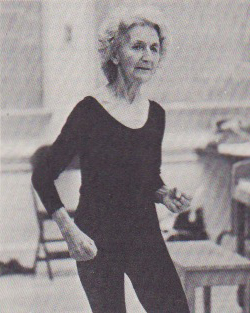
Irmgard Bartenieff (1900-1981) has been characterized as Laban’s most active heir in the United States. She began as a dancer in Germany, studying with Laban, then running a small dance company. With the rise of Nazism, she and her family immigrated to the U.S. in 1936. Unable to work as a dancer, Bartenieff qualified as a physical therapist in 1943 and devoted herself to rehabilitating polio victims. Through this work she realized that the same laws she knew from dancing applied to rehabilitation. This allowed her to see Laban’s theories in a much larger context.
Bartenieff went on to create innovative techniques in physical therapy, to pioneer the new profession of dance therapy, to contribute to cross-cultural ethnic dance research, and to develop a somatic practice now known as Bartenieff Fundamentals. In the mid-1960s, her classes at the Dance Notation Bureau in New York introduced American students to the movement theories she had learned from Laban. Over the next decade, these classes coalesced into a training program in Laban Movement Analysis and led in 1978 to the founding of the Laban/Bartenieff Institute of Movement Studies.
For those lucky enough to study or work with her, Bartenieff remains an inspiration, for her career demonstrated how Laban’s theories could be meaningfully applied to the many different disciplines that deal with human expression and physical function.
